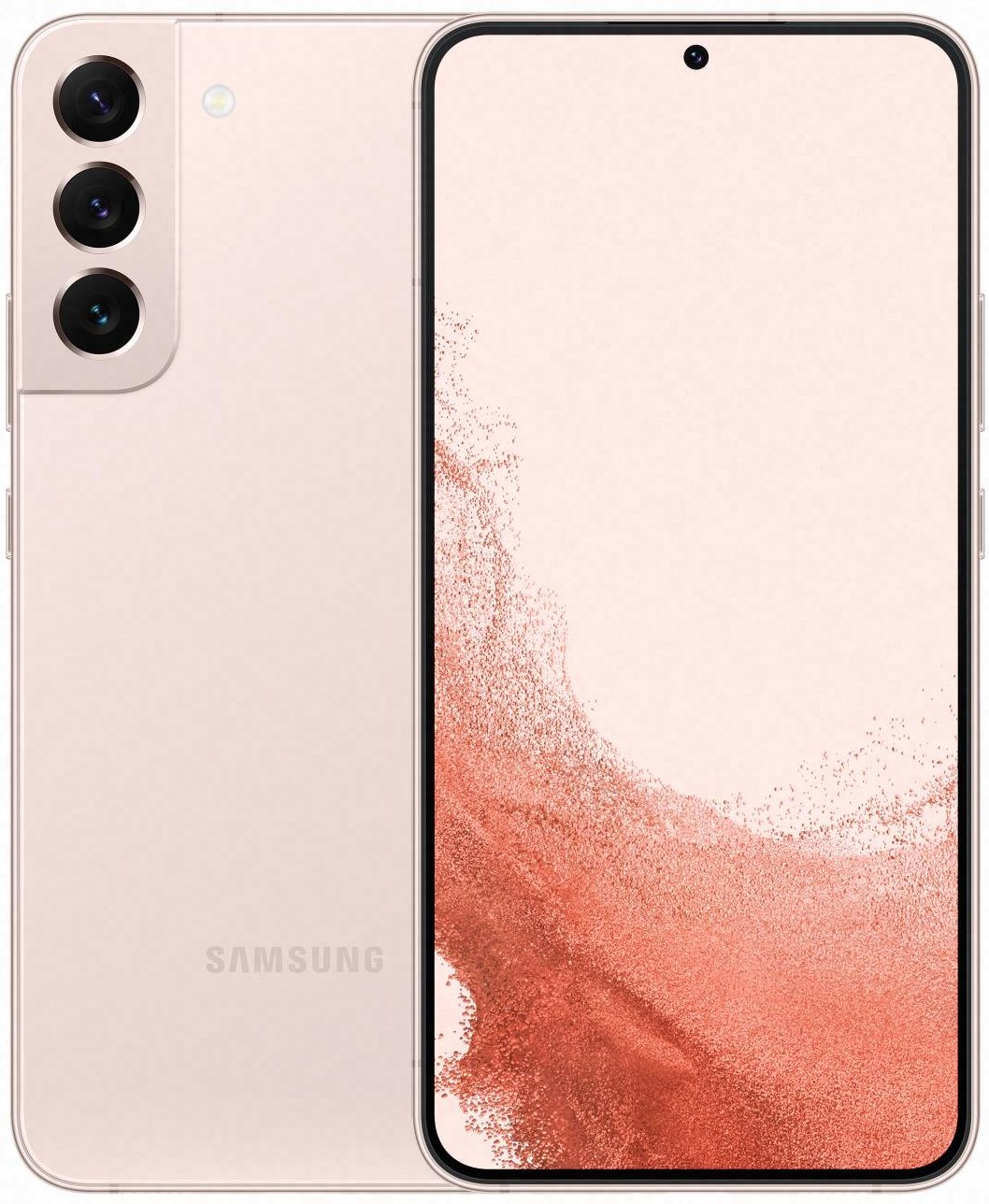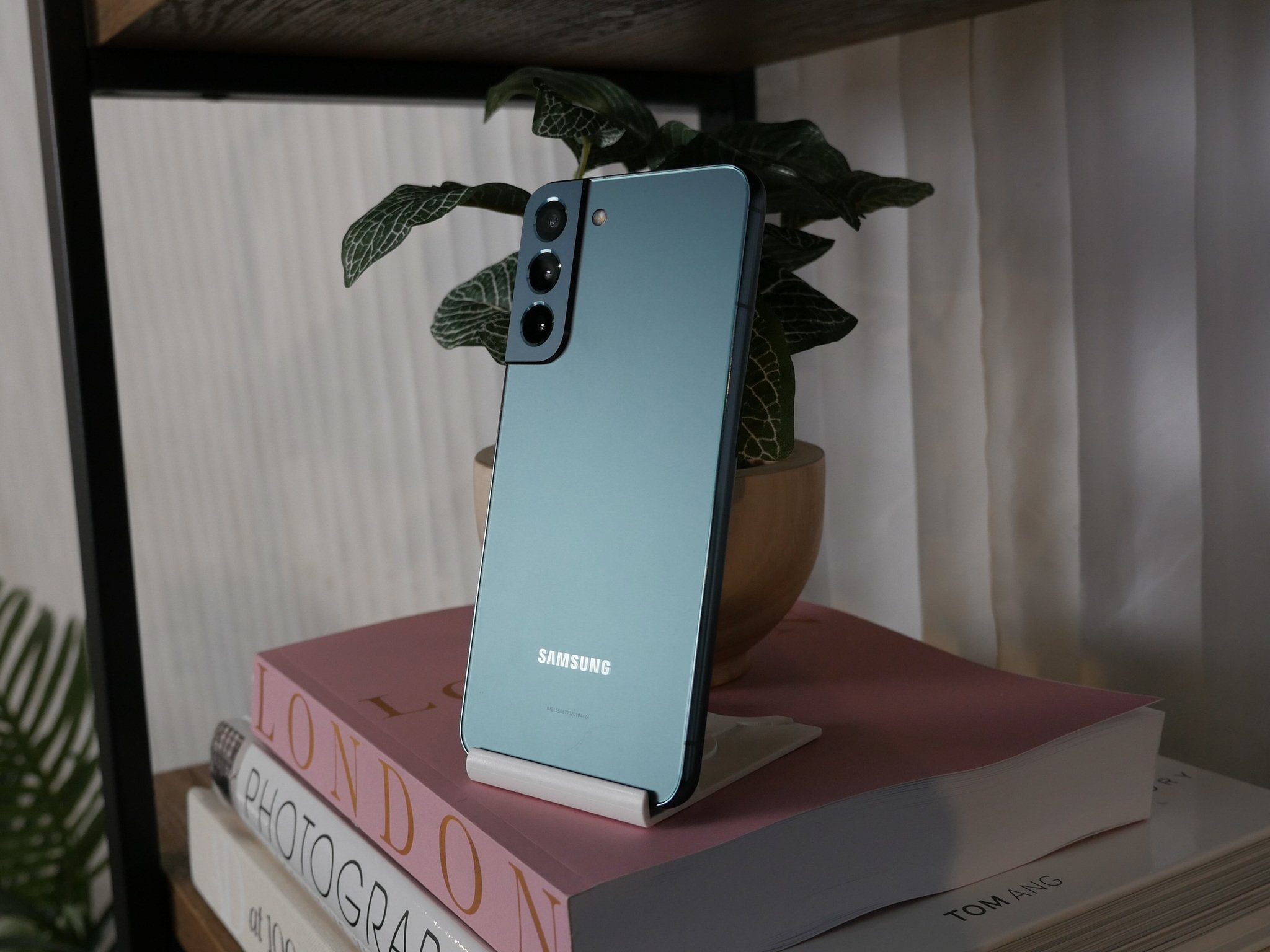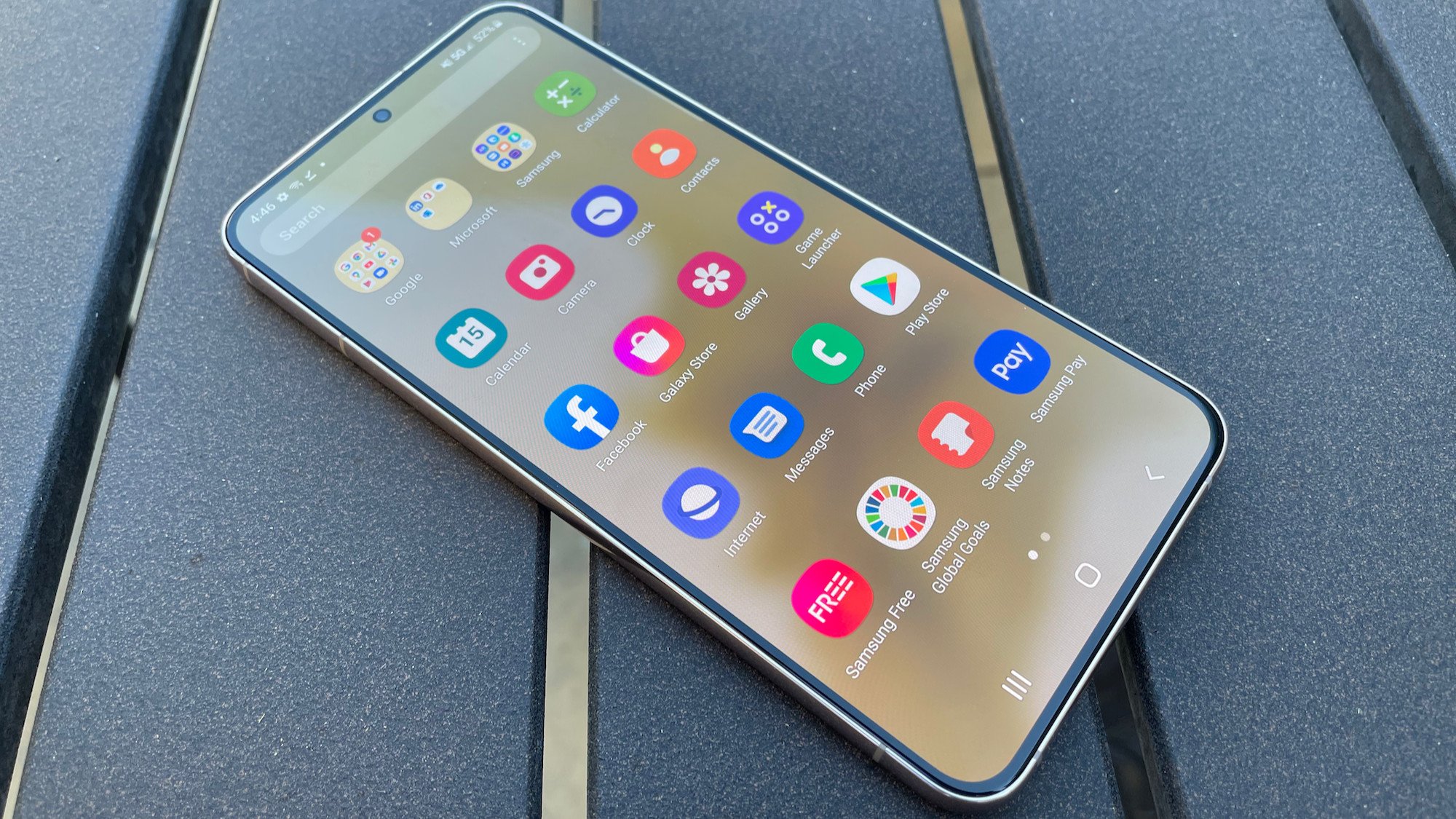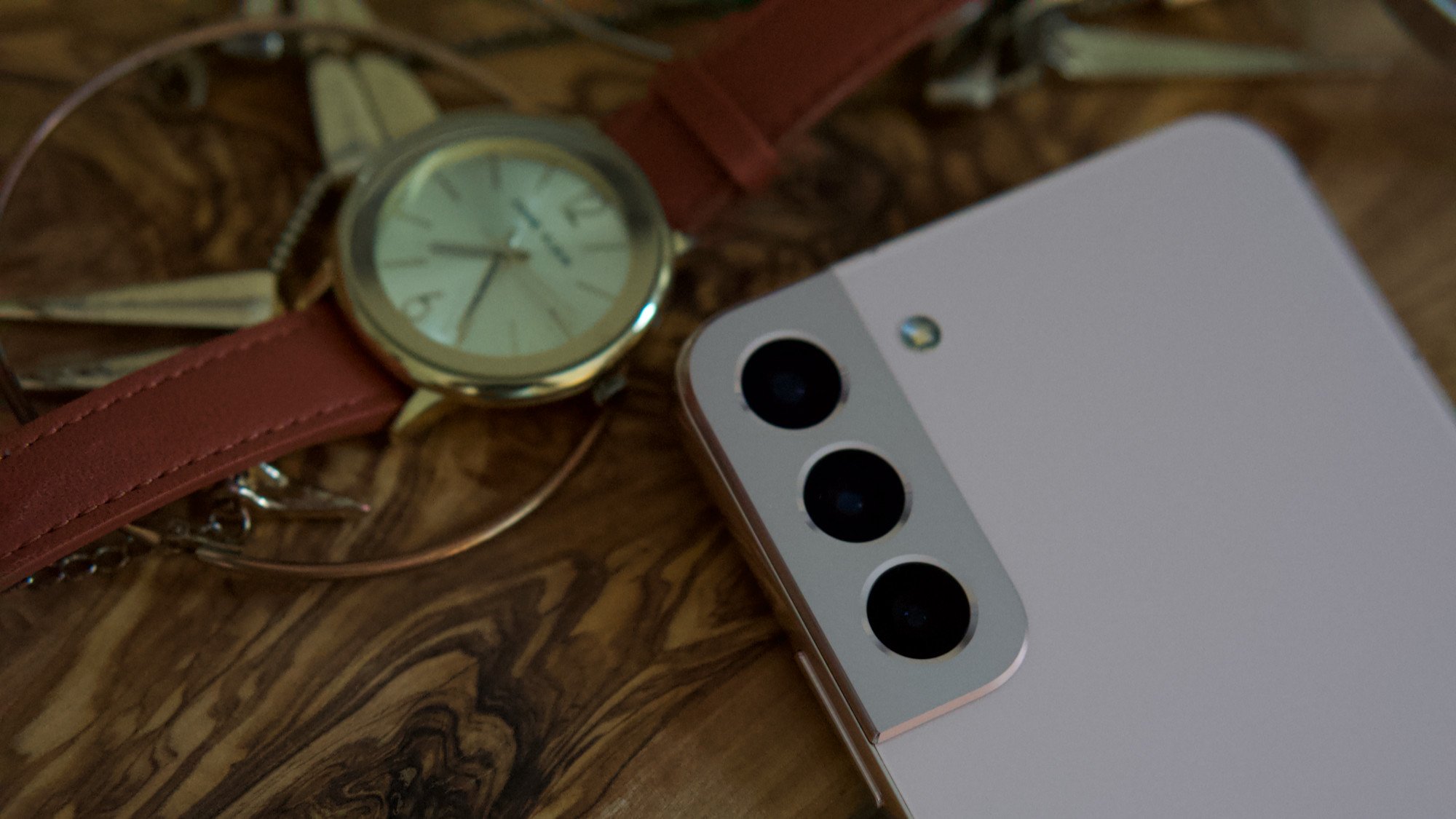The one S22 model where Samsung didn't overcomplicate things.
In terms of pre-release chatter, the Samsung Galaxy S22+ is the phone least likely to inspire much conversation. Below it, you have the affordable, shrunken Galaxy S22 that's the closest Samsung has come to a powerful Mini phone. Above it, you have the reincarnation of the Note lineup disguised as an Ultra flagship. Compared to those, the S22 Plus plays it safe, sticking close to what we saw in its 2021 predecessor.
If the radically redesigned Galaxy S22 Ultra hasn't already tempted you, the S22+ has taken the Ultra's place as the "traditional" Galaxy phone many Samsung fans will prefer. Samsung reserved some key upgrades for the Ultra to upsell you, as it does every year, but the Plus only compromises for specs and features most people can live without.
With the new Snapdragon 8 Gen 1, a blazingly bright display, upgraded rear and front camera sensors, and the best battery life of the S22 lineup, the Galaxy S22+ easily joins the list of the best Android phones available. But should owners of an S21 or S20 phone upgrade? We'll help you decide.
Samsung Galaxy S22 Plus
Bottom line: Sitting between the compact, small-batteried S22 and thick, pricey S22 Ultra, the Galaxy S22+ offers the most traditional flagship form factor. Its flat design is simple but gorgeous, the Snapdragon 8 Gen 1 performance doesn't disappoint, and the camera hardware and software offer a significant step up on the S21. Even the battery life remained reasonably long-lasting despite a downgrade from the S21+. Aside from some minor nitpicks, this is a solid upgrade on last year's model, and you may want to consider it over the S22 Ultra.
The Good
- Fast-refreshing, absurdly bright display
- The best design of the S22 series
- OS updates to Android 16 / security updates through 2027
- Solid camera upgrades with RAW editing
- Surprisingly decent battery life
- 45W charging is blazingly fast
The Bad
- Consistently runs hot while gaming
- Can be tricky to use one-handed
- Still no 3.5mm/ microSD/ charger-in-box
- Only FHD+ at this price
$1,000 at Samsung $1,000 at Amazon $1,000 at Best Buy
Samsung Galaxy S22 Plus: Price, availability, and colors
Samsung announced the Galaxy S22+ at its Winter Unpacked event on February 9, 2022. Allegedly, it pushed the announcement and launch a month to make room for the delayed Galaxy S21 FE. Preorders end February 24, and the phone will officially release and ship on February 25.
The Samsung Galaxy S22+ retails for $1,000, which gives you 8GB of RAM and 128GB of storage. It costs $200 more than the stock S22 and $200 less than the S22 Ultra. For $50 extra, you upgrade to 256GB of storage; you won't find any RAM upgrade options or expandable storage beyond that.
For color options, you'll find the Galaxy S22+ available in Phantom Black, Phantom White, Green, or Pink Gold from all major retailers. Samsung also sells it in Graphite, Sky Blue, Cream, or Violet exclusively from its website — though Sky Blue already shows as out of stock, meaning these variants may have limited stock available.
Preordering through Samsung.com nets you a free 256GB upgrade, $150 in credit for add-ons, enhanced trade-in credit up to $780, and options for exclusive colors not available with other retailers. Other S22+ pre-order deals come from carriers' own enhanced trade-in offers, with AT&T making the phone free with the right trade.
Samsung Galaxy S22 Plus: A familiar, gorgeous design
Take the iPhone 13 Pro Max's back, scrape off the Apple logo, and swap out the Play button-shaped sensor array and square housing for a thinner, vertical camera housing, and you have yourself a Galaxy S22+, more or less. Last year's Galaxy S21 and S21+ flattened the display, but this is the first Galaxy S series to fully flatten the back panel as well. Whether you find it stylish or boring is a matter of preference.
Samsung also raised eyebrows when it returned to a glass back design for the first time since the Galaxy S20. Our S21 reviewer praised the glasstic design for its durability and style, and without reigniting the glass vs. plastic debate, many feared switching back to glass would mean a higher price tag. Thankfully, those fears were ill-founded, but you're still going to want an S22+ case to prevent any unfortunate accidents.
The volume rocker buttons and power button sit on the top-right edge, colored to blend into the aluminum edge so they barely stand out. Otherwise, the top, left, and bottom-right edges lack any textures to bother your fingers as you browse. Thanks in part to Samsung's continued choice to deny its users a 3.5mm headphone jack or microSD card slot, the S22+ can squeeze the bottom-firing speakers, USB-C port, and dual-SIM card slot onto the phone bottom and leave everything else smooth and unblemished.
The camera housing remains mostly unchanged from the S21 lineup in size and layout, especially when looked at directly. On last year's model, it curved and stuck out slightly along the phone's rounded edge. This year, Samsung fully isolated the cameras, with a thin line separating the housing from the S22+'s unblemished edges. The housing color and phone color will match if you choose one of the four main S22+ models, whereas the exclusive Samsung variants have alternate accent colors.
Finding the right grip for one-handed browsing can be a challenge, but it's not nearly as uncomfortable to hold as the boxy S22 Ultra.
If the Galaxy S22+ design has a flaw, it's that its narrow housing causes the phone to wobble if you tap it on a flat, hard surface like a desk — though, again, a case should solve this issue. In general, folks with smaller hands may not find it comfortable to hold a 6.6-inch phone for an extended period of time, with or without a case. Finding the right grip that offers good thumb positioning for one-handed browsing can be a challenge, even for someone with larger hands. But it's not nearly as uncomfortable to hold as the boxy S22 Ultra.
That's not specific to the S22+, which has a decently thin frame compared to other models but is still worth mentioning. At home, I tend to cradle it on my fingertips so my thumb has enough range to reach across, but holding it that way outside would tempt dropping it. On the go, I'm more likely to hold it in my off-hand so I can tap away with my dominant one. If that sounds annoying, you may want to consider the smaller S22 instead, or invest in a Popsocket.
In his S22 hands-on, Android Central's Nick Sutrich called the S22+ design "decidedly manmade" in feel compared to the more natural, rounded texture of older Samsungs. In my case — perhaps because I've used iPhones regularly in the past — I find it much more natural to rest the S22+'s flat edges firmly against my palm without fear of false touches or the edge digging into my hand. To each their own!
I like that Samsung gave use three distinct phone designs by shrinking the S22, Note-ifying the Ultra, and making the S22+ the "traditional" flagship.
Beyond all the nitpicky details, the Galaxy S22+ in Pink Gold looks stunning, with a subtle coloring that isn't quite as shiny as past Mythic models and doesn't accentuate finger smudges. Samsung invited comparisons to the iPhone 13, and I think the narrower S22+ camera housing makes the square iPhone module look excessive or bloated by comparison. Plus, you've dodged a bullet with this housing compared to the S22 Ultra and its unhoused camera sensors, which attract a disgusting amount of dust and lint that ruin the unique look.
Maybe the Galaxy S22 Ultra is the Note 22 in all but name, but I like that Samsung gave us three distinct phone designs by shrinking the S22 and Note-ifying the Ultra. No one paid attention to past Pluses unless they didn't like the Ultra's pricing or large size; now, the S22+ is the "traditional" flagship with a compelling design of its own, and shoppers have good options at each price point.
Samsung Galaxy S22 Plus: A display built for sunlight
Samsung maintained the flat display excellence we saw with last year's phone models. Dynamic AMOLED 2X technology continues to exhibit vibrant, accurate colors that look especially beautiful when playing HDR content. It retains a 120Hz refresh rate for seamless scrolling and 240Hz touch sampling while gaming for the most accurate performance possible. And Samsung added a new Eye Comfort Shield that's an effective blue light filter mode.
| Category | Galaxy S22+ |
|---|---|
| Chipset | Snapdragon 8 Gen 1 or Exynos 2200 |
| Display | 6.6-inch Dynamic AMOLED 2X Display 1080x2340 120Hz refresh rate (48-120Hz) with 240Hz touch sampling Up to 1,750 nits |
| Memory | 8GB RAM |
| Storage | 128-256GB |
| Rear cameras | 50MP, ƒ/1.8, 1.0μm, (85-degree wide-angle) 12MP, ƒ/2.2, 1.4μm (120-degree ultra-wide) 10MP, ƒ/2.4, 1.0μm, 3x optical zoom (telephoto) |
| Front camera | 40MP, ƒ/2.2, 80-degree wide-angle |
| Battery and charging | 4,500mAh 45W Fast Charging 15W Wireless Charging |
| Connectivity | WiFi 6E (6GHz) Bluetooth 5.2 5G mmWave and sub6 Ultra wideband |
| Dimensions | 75.8 x 157.4 x 7.6 mm / 2.98 x 6.2 x 0.3 in 196g / 6.9oz |
| Protection | IP68 Gorilla Glass Victus |
| Colors | Phantom Black, Phantom White, Green, Pink Gold (Samsung.com exclusives) Graphite, Sky Blue, Cream, Violet |
The major improvement for this year's model is Vision Booster, which supercharges the display up to 1750 nits (according to Samsung) to keep it visible in direct sunlight. Last year's model (and the base S22) hit 1300, so you can easily read or watch content outside, but that extra 450 nits changes the game for people like myself who live in sunny climates.
According to lab-test results from our parent company, Future, it measured slightly above 1,300 nits, compared to merely 830 nits on the S21 Ultra. While both results fell short of the marketing, it's clear at least that the 450-nit increase over last year's model isn't false advertising. And in practice, the S22+ quite simply keeps the display visible in California sunlight, even when streaming content outside — though it'll drain your battery with prolonged use.
Only the Galaxy S22 Ultra offers QHD, but only at 60Hz, and Samsung defaults its flagship to 120Hz at FHD for a reason. The Android Central forums largely prefer 120Hz and have trouble going back to 60Hz now, whereas they barely notice the difference in resolution between 1080p and 1440p. Overall, the S22+'s 393 pixels-per-inch ratio is perfectly pleasant for visual quality. Still, other $1,000 phones largely offer QHD, so you may resent that you can't choose for yourself.
What matters more is that the S22 Ultra has an LTPO display that supports refresh rates as low as 1Hz for prolonging battery life. Samsung originally claimed the S22 and S22+ ranged from 10Hz to 120Hz for similar results, but recently updated its news release to note the refresh rate range is 48Hz-120Hz. It later told Phone Arena that the "data transfer rate" drops as low as 10Hz, sparing the processor a bit, the display still sticks to 48Hz or higher — which will give your battery a tougher time.
 Watching an HDR video in direct sunlight with no problems
Watching an HDR video in direct sunlight with no problems
All three Galaxy S22 models have an under-display fingerprint sensor, and given the Pixel 6's optical fingerprint sensor woes, it's a relief that Samsung's ultrasonic sensor works near-instantaneously — and that isn't hyperbole.
Add in attractively thin bezels and the option to manually change the color mode or RGB settings, and you'll have very few complaints with the S22+ display aside from the lack of LTPO support. Brightness, vivacity, and customization all make it a pleasure to use.
Samsung Galaxy S22 Plus: Familiar software, spicy performance
Launching with One UI 4.1 based on Android 12, the Galaxy S22 UI will look very familiar to the many Samsung phone owners who have already received the One UI 4.0 update. From Material You theming to revamped widgets, along with revamped privacy features and notifications, the look and utility of 4.1 appears largely unchanged. Whether or not you enjoy the rounded, colorful look that matches your wallpaper of the day, Samsung's default launcher remains the same as ever.
Instead of a redesign, 4.1 primarily offers improvements to the camera and video software, which we'll cover below. Otherwise, it's all about bringing Samsung and Google closer together: it makes Google Messages the default app over Samsung Messages — giving RCS a boost — and enables Google Duo Live Sharing for sharing your screen with friends or hosting YouTube watch parties — but only on Galaxy and Pixel devices, excluding other Android phones.
Maybe Samsung and Google want to recreate the mystique and exclusivity of Apple SharePlay, or non-Samsung phones aren't trusted to support the feature reliably. Regardless, it's a bizarre choice in my book that seems likely to limit its cultural impact. The feature won't become available until later in the month, when I'll test it and update the review.
Samsung has become the undisputed champion of Android updates.
What really matters here is that Samsung has become the undisputed champion of Android updates in both speed and longevity. The Galaxy S22 will receive four software updates through Android 16, plus five years of security updates. More importantly in my book, Samsung has begun updating three-year-old flagships like the S10 as early as January, so you know your S22+ should remain a priority for updates years later — while other brands would keep you waiting through the spring or summer.
Now, let's talk performance. I received the Snapdragon 8 Gen 1 variant exclusive to the U.S., Canada, and China, so everyone else due for the Exynos 2200 should wait for our international phone review. But it shouldn't surprise anyone that a flagship-priced phone would have the speed to match.
Both the fingerprint sensor and Face Unlock open the phone faster than you can snap your fingers. The Snapdragon never appears to lag behind the 120Hz maximum, so scrolling and swiping looks smooth and stylish without fail. Apps or Chrome web pages load faster than on any phone I've tested before. I've had no trouble taking photos, with the cameras quickly capturing shots with little lag. Even downloading Play Store apps takes less time than ever; whether that's due to the CPU or the Wi-Fi 6E support maximizing my network capacity, I'm grateful for it.
With all that being said, Samsung chose to keep the Galaxy S22 Plus at 8GB with no 12GB upgrade option. Similarly priced phones like the Pixel 6 Pro or OnePlus 9 Pro offer 12GB, and I'd argue Samsung fell into archaic thinking by reserving a memory upgrade for the flagship only. If you're going to make the Ultra a Note, then don't punish the people who'd rather buy a proper Galaxy S phone.
The S22+ gets consistently warm (bordering on hot) trying to keep up with demanding Android games — but it can play them.
I'll stress that this matters very little for day-to-day use. But when playing some of the more graphically demanding Android games like Genshin Impact or Sky: Children of the Light, or when filming 4K video, I found the phone got consistently warm (bordering on hot) under my fingers trying to keep up, even on just Medium graphics. And while testing the S22 Ultra (with its superior RAM), my colleague encountered a GPU overheating crash, though only once.
The S22+ can very easily handle all of the best Android games or cloud gaming. But the overheating does prove that the Snapdragon 8 Gen 1 is getting a proper workout playing these games, and I want to keep an eye on it for a month to see if it persists.
If you care about benchmarks — which people generally care about way too much — the Galaxy S22+ hits 1214/3361 in single-core/multi-core Geekbench 5, 1072 in overall CrossMark score, and 2449 in 3DMark Wild Life Extreme Unlimited.
Samsung Galaxy S22 Plus: Bet on its battery to last
Given Samsung shrunk the Plus battery from 4,800mAh last year to 4,500mAh this year, I came into my Galaxy S22+ review expecting the worst on this front. Instead, I came away impressed with the phone's longevity and ability to hold a charge when not in active use.
Across its first full day of use, during which I was actively downloading and playing massive titles like Genshin — and the S22+ was running so hot, it felt at times like I'd left it in the sun on asphalt — it lasted 12 hours with 5 hours of active screen time and with 20% battery remaining.
Left overnight unplugged, it remained at 15% after about 10 hours of idle time. Then, plugged in using a 45W-capable charger I own, it recharged in less than an hour. It's frustrating that Samsung didn't include a charger in the box, but with a compatible charger for $30 or so, you'll have the option to top off a drained phone with some emergency juice in just a few minutes.
Across my next day of active testing, 5 hours of fully active screen time — including gaming, streaming, Slacking, Chrome browsing, camera testing, calling home, and two extra hours of idle time — took the phone to just 50% battery life. My phone typically never gets that kind of attention, but it's nice to know that if I go on a gaming binge or stream an HDR10+ movie in bed, it won't completely destroy the battery.
Don't stress about the S22+'s battery "downgrade" compared to last year. It didn't have any practical, negative impact that I could measure.
Our parent company's S22+ stress test looked a bit less favorably on the battery life, as it lasted slightly less than 10 hours while constantly loading content over 5G on low brightness — a few minutes below the S21+ in total duration. But the S22 Ultra lasted an hour less under the same conditions despite its larger capacity, and my colleague regularly fell into the single digits with regular use by end of the day, while I still had plenty of juice.
In other words, don't stress about the S22+'s battery "downgrade" compared to last year. It didn't have any practical, negative impact that I could measure.
Samsung Galaxy S22 Plus: Upgraded (if unremarkable) cameras
Given Samsung retained the S20 camera sensors for the S21 lineup and only upgraded the software, we were overdue for a hardware upgrade this year. On this front, Samsung only partially delivered: the 12MP ultra-wide and 12MP 3X-optical zoom telephoto lenses remain the same as they did in 2020. But it did upgrade the main sensor from 12MP to 50MP and the selfie camera from 10MP to 40MP, so at least its point-and-shoot photography got the boost it needed.
Samsung also credits the revamped neural processor in the Snapdragon 8 Gen 1 for improved night photography and its "AI Stereo Depth Map" for better focus in portrait shots.
In practice, the Galaxy S22+ takes perfectly respectable photos with good color accuracy and decent detail, though you do tend to see some blur once you zoom in past 3X. Portrait mode does seem capable of capturing some beautiful shots with a stylish focus on the subject.
Fast processing speed ensures the camera captures its subject quickly; I was able to get some action shots of birds flying or cars driving by with decent crispness, though in other cases moving people or pets looked blurrier than I'd have liked. Compared to the Pixel 6 lineup, the S22 phones seem to have more trouble on this front.
Overall, it's fair to say that the S22+ beats mid-range phones for photo quality, but with so many Android brands developing or using 100-200MP camera sensors, it's fair to say the S22+ feels a bit last-gen compared to the S22 Ultra, Pixel 6 Pro, and other flagships with similar pricing.
Samsung Galaxy S22 Plus: Competition
If you're looking for a "flagship" that matches the Galaxy S22+ in most specs, you'll want to look at the Pixel 6 Pro. For $100 less, you get 12GB of RAM, QHD+ resolution as an alternative to the 120Hz mode, a 5,000mAh battery, and access to Google Tensor AI features that Samsung phones largely don't have yet. On the flip side, the 6 Pro has slower charging, Tensor falls short of the Snapdragon 8 Gen 1 in benchmarks, the curved display is dimmer, and Pixels have dealt with fingerprint and cellular issues since launch.
If you want a true one-handed phone, you may consider the Galaxy S22, which has the same performance and cameras as the S22+. But you do lose 450 nits of brightness and ultra-wideband, drop down to 25W charging and 3,700mAh capacity, and regress to Wi-Fi 6 instead of 6E.
Or, of course, you can choose the Galaxy S22 Ultra for an extra $200 — or $300 if you want 12GB of RAM. That upgrades you to QHD+ resolution, a possible 512GB or 1TB of storage, a 108MP main sensor and a second telephoto lens with 10X zoom, and a built-in S Pen. Just be prepared for a phone that's even less suited to one-handed use than the S22 Plus!
Samsung Galaxy S22 Plus: Should you buy it?
You should buy this if...
- You regularly browse your phone out of doors
- You want top-class hardware that'll last for years
- You care more about smooth scrolling than resolution
You shouldn't buy this if...
- You want cameras with powerful zoom and next-gen resolution
- You struggle to hold large phones
- You're happy with your current S21
Whether you own a budget phone or recent flagship, you'll love the outdoor screen brightness, smooth scrolling, and workhorse battery life of the Galaxy S22+. The Snapdragon 8 Gen 1 offers a 30%-ish performance upgrade on the Snapdragon 888, and if you find a clear case, you'll enjoy the phone's look without risking a glass-shattering disaster.
That being said, S21 owners shouldn't let fear of missing out push them into an expensive upgrade they don't need. The 888 hasn't lost its edge yet, and One UI 4.1 doesn't seem to have any S22-exclusive features that other Samsung phones won't get. Outside of the Material You coat of paint, not much has changed this year, and new camera features like the Expert RAW app will come to older Samsung phones too.
If you do need a new phone, Samsung made a very strong contender for your business with the S22 Plus. Especially if you can snag one at a discount with a carrier deal and trade-in or a holiday deal down the line. While you may be tempted by the expensive, two-handed Galaxy S22 Ultra, you should consider the Plus as a strong alternative instead.
Samsung Galaxy S22 Plus
Bottom line: While many Android fans will disagree, I think the Galaxy S22+ is the best of Samsung's 2022 phones thus far. The hardware, design, display, battery life, and new cameras make a strong case for this phone's quality while avoiding the burdensome price and controversial design of the S22 Ultra.





























Tidak ada komentar:
Posting Komentar